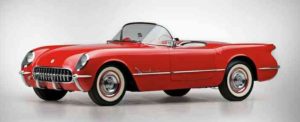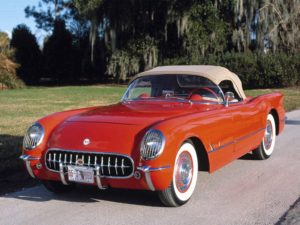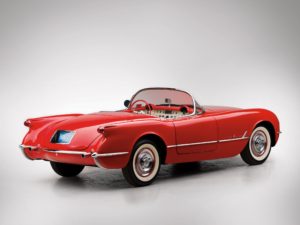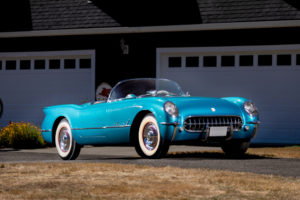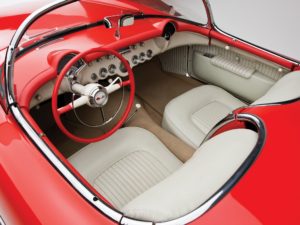The Corvette engineering corps wanted more power. Corvette advertisers wanted more power. Corvette aficionados wanted more power. The Ford Thunderbird team…well, they probably would have preferred that the Corvette stick to its Blue Flame Six engine for another few years at least. But more power is exactly what the Corvette got. For the 1955 model year, Chevrolet’s two-seater finally gained the muscle to fulfill the promise of its catch-me-if-you-can exterior. V-8 power had arrived. And the Corvette would never be without it again
Pricing: $2774.00
Transmission: 2 Speed Powerglide Automatic or 3 Speed Manual
Engine options: “Blue Flame” Inline-6 or 265-cid small-block V-8
Top speed: 120mph
Units produced: 700
Available colours: Polo White, Harvest Gold, Gypsy Red, Corvette Copper, Pennant Blue (replaced by Harvest Gold in 1955)
Highlights of the year:
Edward N. Cole, Chief Engineer for GM’s Chevrolet Division, led the process to develop a new power plant that was ready for production which would, ultimately, play a pivotal part in the re-birth of Corvette into American culture: the amazing new 265-cid small-block V-8.
This engine, which he had been developing for Chevy’s totally redesigned passenger cars, would become the “heart and soul” of the 1955 Corvette
The original intent of the 265-cid V-8 was to have a capacity of 231 cubic inches, which made it physically smaller than the “Blue Flame” six-cylinder of the 1953 and 1954 Corvette. It was Edward Cole that had the engine’s capacity increased to 265 cubic inches. Cole also reworked the cylinder heads, concentrating on efficient gas flow and better combustion.
Upon completion, this V-8 engine was 300lbs lighter than the ‘Stovebolt Six” and was a remarkably compact unit. The inclusion of a short-stroke crankshaft allowed the engine to rev to 6,000rpmAt about the same time, a new member had allied himself with the Corvette engineering team.
The new 1955 “Turbo-Fire” V-8 did wondrous things for the Corvette’s performance. Developing 195 horsepower, a 40-hp improvement over the Blue Flame Six, the V-8 helped the Vette sprint from 0 to 60 mph in roughly 8.5 seconds — more than two seconds quicker than the six-cylinder car. (A new three-speed manual transmission, unveiled in late ’55, helped improve acceleration even more.) Top speed climbed from 107 mph to 120. Remarkably, even the fuel economy improved. The Corvette was fast becoming a true no-excuses sports machine.
Of course, the refinement of the car was not limited solely to the engine, although the addition of the V-8 certainly encouraged other accommodations to be made to the car. For the first time since the original 1953 Motorama Corvette, an automatic choke was included as well as a modern 12 volt electrical system, though the older 6-volt system was retained for the few six-cylinder Corvettes that were built that year. Electric wipers replaced vacuum-operated units and foot-operated windshield washers were included.
Tires changed from tube type to the tubeless variety and were available in both white wall and black wall versions. Although the Powerglide two-speed automatic remained for most of 1955, about 75 cars were built with Corvette’s first manual gearbox. This was a new close-ratio three-speed manual transmission which was shifted via a stubby chrome shifter rod capped by a small, white ball and surrounded by a boot that was clamped to the floor by a bright metal ring showing the shift pattern.
As a whole, 1955 marked a pivotal year for the engineering behind the Corvette, despite the fact that sales continued to be an overwhelming failure. In 1955, only 700 were produced by GM for the model year, and of these, only 674 were actually sold. It appeared that GM had learned from their previous model years over-production mistakes.
Photos of the 1955 Corvette
Sources:
https://www.caranddriver.com/reviews/a15143945/1955-chevrolet-corvette-road-test/
https://www.corvsport.com/1955-c1-corvette/
https://www.corvsport.com/1955-c1-corvette-image-gallery/
